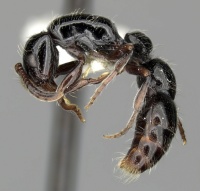Lioponera aberrans
| Lioponera aberrans | |
|---|---|

| |
| Scientific classification | |
| Kingdom: | Animalia |
| Phylum: | Arthropoda |
| Class: | Insecta |
| Order: | Hymenoptera |
| Family: | Formicidae |
| Subfamily: | Dorylinae |
| Genus: | Lioponera |
| Species: | L. aberrans |
| Binomial name | |
| Lioponera aberrans (Clark, 1934) | |
Identification
Distribution
Latitudinal Distribution Pattern
Latitudinal Range: -16.80999947° to -16.80999947°.
| North Temperate |
North Subtropical |
Tropical | South Subtropical |
South Temperate |
- Source: AntMaps
Distribution based on Regional Taxon Lists
Australasian Region: Australia (type locality).
Distribution based on AntMaps
Distribution based on AntWeb specimens
Check data from AntWeb
Countries Occupied
| Number of countries occupied by this species based on AntWiki Regional Taxon Lists. In general, fewer countries occupied indicates a narrower range, while more countries indicates a more widespread species. |

|
Estimated Abundance
| Relative abundance based on number of AntMaps records per species (this species within the purple bar). Fewer records (to the left) indicates a less abundant/encountered species while more records (to the right) indicates more abundant/encountered species. |

|
Biology
Castes
Nomenclature
The following information is derived from Barry Bolton's Online Catalogue of the Ants of the World.
- aberrans. Phyracaces aberrans Clark, 1934b: 25, pl. 2, fig. 6 (w.) AUSTRALIA (Queensland).
- Type-material: holotype (?) worker.
- [Note: no indication of number of specimens is given; Taylor & Brown, 1985: 23, suspect a syntype series.]
- Type-locality: Australia: N Queensland, Kuranda (F.P. Dodd).
- Type-depository: SAMA.
- Combination in Cerapachys: Brown, 1975: 22;
- combination in Lioponera: Borowiec, M.L. 2016: 163.
- Status as species: Brown, 1975: 22, 67; Taylor & Brown, 1985: 23; Taylor, 1987a: 16; Bolton, 1995b: 142.
- Distribution: Australia.
Type Material
- Phyracaces aberrans: Syntype, worker(s), Kuranda, Queensland, Australia, South Australian Museum.
Description
References
- Bolton, B. 1995b. A new general catalogue of the ants of the world. Cambridge, Mass.: Harvard University Press, 504 pp. (page 142, catalogue)
- Borowiec, M.L. 2016. Generic revision of the ant subfamily Dorylinae (Hymenoptera, Formicidae). ZooKeys 608: 1-280 (doi:10.3897/zookeys.608.9427).
- Brown, W. L., Jr. 1975. Contributions toward a reclassification of the Formicidae. V. Ponerinae, tribes Platythyreini, Cerapachyini, Cylindromyrmecini, Acanthostichini, and Aenictogitini. Search Agric. (Ithaca N. Y.) 5(1 1: 1-115 (page 22, Combination in Cerapachys)
- Clark, J. 1934b. New Australian ants. Mem. Natl. Mus. Vic. 8: 21-47 (page 25, pl.2, fig.6 worker described)
References based on Global Ant Biodiversity Informatics
- Brown W. L., Jr. 1975. Contributions toward a reclassification of the Formicidae. V. Ponerinae, tribes Platythyreini, Cerapachyini, Cylindromyrmecini, Acanthostichini, and Aenictogitini. Search Agric. (Ithaca N. Y.) 5(1): 1-115.
- CSIRO Collection
- Clark J. 1934. New Australian ants. Memoirs of the National Museum, Victoria 8: 21-47.
- Taylor R. W. 1987. A checklist of the ants of Australia, New Caledonia and New Zealand (Hymenoptera: Formicidae). CSIRO (Commonwealth Scientific and Industrial Research Organization) Division of Entomology Report 41: 1-92.
- Taylor R. W., and D. R. Brown. 1985. Formicoidea. Zoological Catalogue of Australia 2: 1-149.

